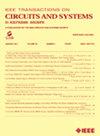时变矩阵Moore-Penrose逆的无逆混合时空导数神经网络及其电路原理图
IF 4
2区 工程技术
Q2 ENGINEERING, ELECTRICAL & ELECTRONIC
IEEE Transactions on Circuits and Systems II: Express Briefs
Pub Date : 2025-01-16
DOI:10.1109/TCSII.2025.3530639
引用次数: 0
摘要
本文简要介绍了无逆混合时空导数神经网络(IHSTDNN),这是一种结合梯度神经网络(GNN)和归零神经网络(ZNN)原理来解决时变矩阵Moore-Penrose逆问题的新型神经网络。IHSTDNN具有明确的动态结构,消除了逆操作的需要。概述了其电路设计,并从理论上检验了模型的收敛性和鲁棒性。数值模拟和实验数据表明,IHSTDNN优于其他现有模型,具有更快的收敛速度和更小的稳态误差。本文章由计算机程序翻译,如有差异,请以英文原文为准。
Inverse-Free Hybrid Spatial-Temporal Derivative Neural Network for Time-Varying Matrix Moore–Penrose Inverse and Its Circuit Schematic
This brief introduces the Inverse-free hybrid spatial-temporal derivative neural network (IHSTDNN), a novel neural network that integrates principles from gradient neural networks (GNN) and zeroing neural networks (ZNN) to address the time-varying matrix Moore-Penrose inverse. The IHSTDNN features an explicit dynamic structure, eliminating the need for inverse operations. The design of its circuit is outlined, and the model’s convergence and robustness are examined theoretically. Numerical simulations and experimental data demonstrate that the IHSTDNN outperforms other existing models, achieving a faster convergence rate and reduced steady-state error.
求助全文
通过发布文献求助,成功后即可免费获取论文全文。
去求助
来源期刊
CiteScore
7.90
自引率
20.50%
发文量
883
审稿时长
3.0 months
期刊介绍:
TCAS II publishes brief papers in the field specified by the theory, analysis, design, and practical implementations of circuits, and the application of circuit techniques to systems and to signal processing. Included is the whole spectrum from basic scientific theory to industrial applications. The field of interest covered includes:
Circuits: Analog, Digital and Mixed Signal Circuits and Systems
Nonlinear Circuits and Systems, Integrated Sensors, MEMS and Systems on Chip, Nanoscale Circuits and Systems, Optoelectronic
Circuits and Systems, Power Electronics and Systems
Software for Analog-and-Logic Circuits and Systems
Control aspects of Circuits and Systems.

 求助内容:
求助内容: 应助结果提醒方式:
应助结果提醒方式:


